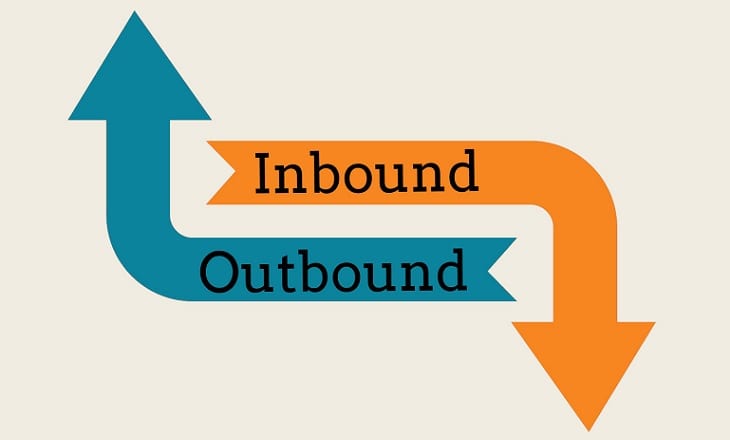The following article was written by Adinah Brown, content manager at Leverate.
Which is better, outbound or inbound marketing?
The fact is, there’s no use weighing in on the argument. Each has its pros and cons, and just like most of the popular digital marketing strategies today, a little bit of both is often better than sticking to just one.
Outbound Marketing
Typically disruptive, “call-to-everyone” type of communication, outbound marketing is the traditional method of advertising through television, radio, newspaper, and now, on search engines, websites and other online channels. Although a classic, this marketing strategy is by no means outdated; many industries, including the financial investment sector, can still benefit from it.
Despite its wide use, online outbound marketing is facing roadblocks – quite literally, as a matter of fact. Adblocking has grown immensely popular (Adblocker Plus has had over 300 million downloads as of 2016) as Internet users suffered from ad fatigue and sought out methods to block unwanted advertisements.
How do you react when you click on an article and a pop-up ad appears just as you’re reading the first sentence? You probably close it immediately without registering what the ad is offering.
This explains why audiences consider outbound marketing disruptive, even intrusive and marketers consider it ineffective. These types of ads force themselves on people whether they are welcome or not. Due to the oversaturation of online ads, Internet users have grown immune and blind to their presence. Hence, dependence on outbound marketing alone is not a smart strategy.
Inbound Marketing
Inbound marketing, a more passive and segmented type of marketing, is a subtler yet proactive approach towards drawing in potential customers. Its protagonist? Content marketing. Content marketing is all about providing valuable content to audiences. Marketers advocate this marketing technique more than the outbound variation because of the long-term benefits it offers:
- Brand awareness. Audiences may see your published content weeks, months, and even years after you first publish it. Your conversion funnel will keep bringing in leads even without your active promotion.
- Economical. An inbound marketing strategy is 62% less expensive than outbound.
Through inbound marketing, people who are interested in your industry, product, or services will actually want to consume your content. Marketers use a wide range of formats to attract potential customers. Content marketing may be delivered in the form of blogs, infographics, videos, case studies, white papers, newsletters, and so forth.
The goals for this style of marketing are pretty straightforward:
- To build a relationship with your audience.
- To entice them to interact with the content through commenting and, more importantly, sharing.
- To create a positive impression on the industry, product, or brand (this is possible for content that bears a disclosure of the brand or company behind it). This explains why it is important to produce high-quality and informative content that your target audience will find valuable.
- To potentially influence the audience’s purchasing decision whether they decide to convert now or in the future.
In essence, inbound marketing is a subtle marketing technique that catches a reader’s attention through non-invasive methods. With the right kind of content, it can nudge customers into the conversion funnel without them feeling pushed through it.
Integrated Marketing: The Power of a Synergistic Marketing Strategy
Outbound marketing calls out to everyone, gaining wide scale, if not superficial exposure. Although the leads from outbound marketing are limited, they are ripe and sales-ready. In contrast, inbound marketing targets a specific audience and draws them in, seeking to influence the reader to behave in a certain way. This strategy brings customers who are more comfortable moving at their own pace.
So, where do these two marketing strategies intersect? How do you combine their strengths to get the best results?
Audience Targeting and Content Curation
Social media networks and Google are now refining their advertising platforms to allow advertisers to show their ads to targeted audiences. Furthermore, they urge advertisers to refrain from using spammy ads by ranking content marketing materials with valuable content.
This is where inbound and outbound marketing may find a convergence you can benefit from.
In practice, you may combine both marketing techniques to full effect through these methods:
Blogging. Regularly publish new content to increase your site’s authority. It won’t cost you money, and it helps with your SEO.
Social Media. According to a survey, 74% of people use Facebook for professional reasons. This means there’s a good chance you can reach your target audience and invite new prospects when you’re active on social media.
Native Advertising. Bring your content beyond your domain and to a larger but still targeted audience.
Paid Ads. Whether it’s a Facebook post or ad banner, curate the graphics and text to overcome ‘banner blindness’. Moreover, enjoy the convenience of a marketing strategy that requires minimal touch-ups after deployment.
These integrated marketing strategies are opportunities for you to highlight the best aspects of your business, product or service. As no definitive rule dictates how far toward inbound or outbound marketing you should lean to, you’ll be playing it by ear. Be observant, measure your results, and you’ll figure out the right combination of the two that work best for your business.
